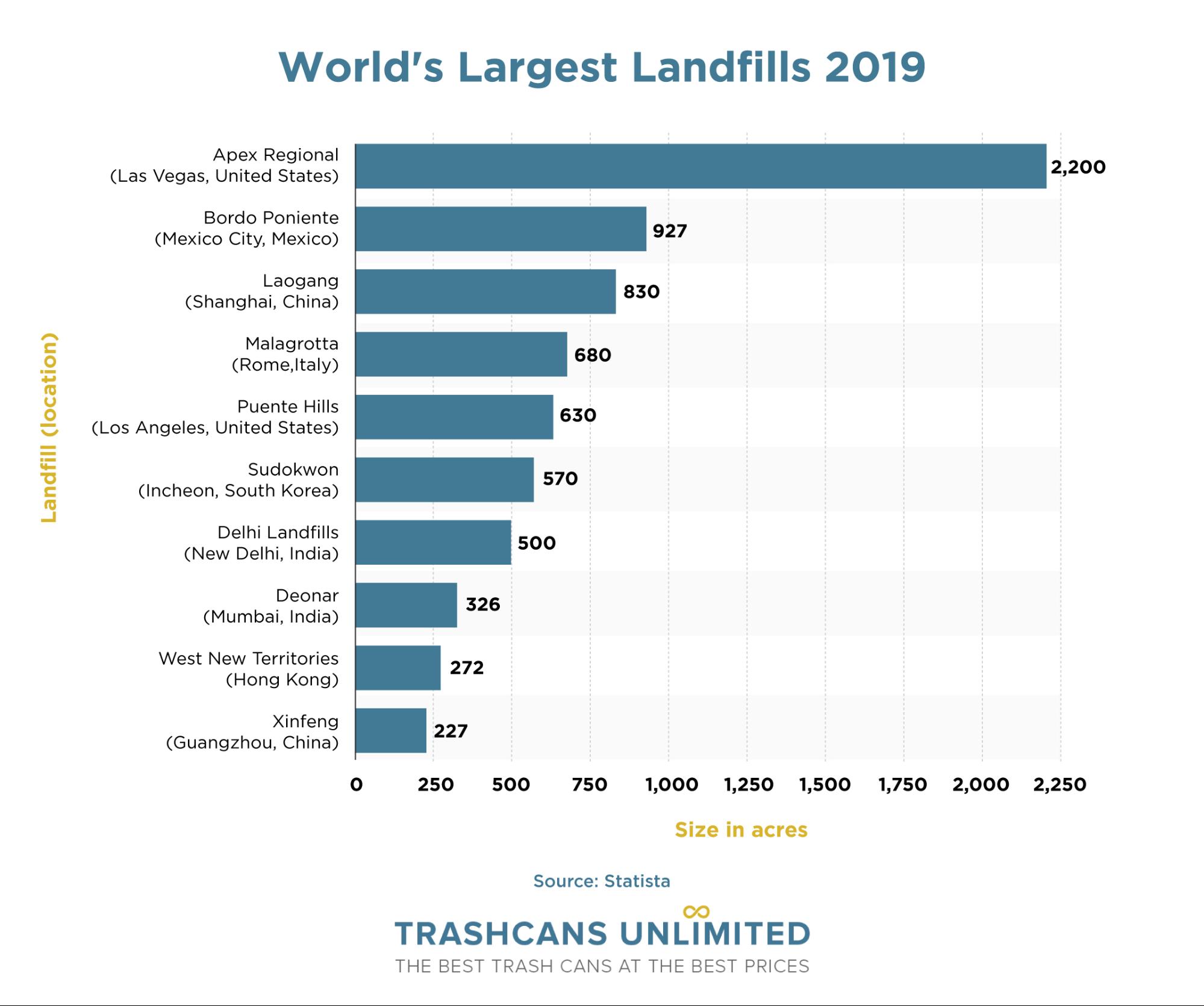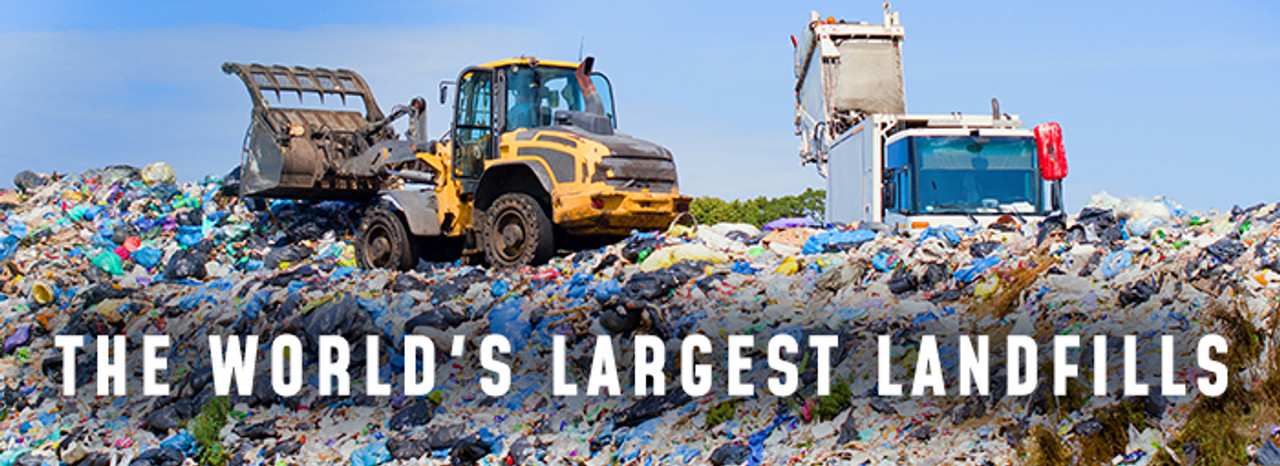It's no secret that the Earth has a waste problem. Whatever we can't reuse, recycle, or compost goes into the trash can, and ends up in a landfill.
The biggest landfill in the world is located in Las Vegas, Nevada. Currently, the Apex Regional Landfill covers approximately 2,200 acres of land. The landfill holds approximately 50 million tons of waste and is projected to have a lifetime of about 250 years.
But what exactly does that mean and why does it matter? Keep reading to learn more about the largest landfills in the world and their effect on the environment.
What Is a Landfill?
A landfill is a site where refuse and other waste material are disposed of by burying and covering them with soil, especially as a method of filling in or extending usable land. There are four different types of landfills, including Municipal solid waste, hazardous waste, industrial waste, and green waste landfills.
Landfills are often located in designated locations and are operated and monitored to ensure that they comply with Federal rules and regulations. And even though there are monitoring systems that help check for any signs of landfill gas and groundwater contamination, landfills are still a problem to the environment.

What Are the Biggest Landfills in the World?
So, what is the "biggest" landfill? We're defining the largest landfill by 3 criteria:
- Area (acres)
- Tons per day
- Tons per year
10 Biggest Landfills in the World by Area
Here are the largest landfills in the world (and their location) based on acres:
- Apex Regional (Las Vegas, United States) - 2,200 Acres
- Bordo Poniente (Mexico City, Mexico) - 927 Acres
- Laogang (Shanghai, China) - 830 Acres
- Malagrotta (Rome, Italy) 680 Acres
- Puente Hills (Los Angeles, United States) - 630 Acres
- Sudokwon (Incheon, South Korea) - 570 Acres
- Delhi Landfills (India) - 500 Acres
- Deonar (Mumbai, India) - 326 Acres
- West New Territories (China, Hong Kong) - 272 Acres
- Xinfeng (Guangzhou, China) - 227 Acres
15 Biggest Landfills in the World by Tons Per Year (Millions)
Here's a list of the world's biggest landfills from smallest to largest, including tons of waste per day, tons per year, their location, and their involvement in green technology:
15. Guatemala City Dump
Location: Guatemala City, Guatemala
Type: An open dump that includes medical waste
Acres: 40
Tons Per Day: 500
Tons Per Year (In Millions): 0.18
Involvement in Green Technology: Methane transformation to energy
14. Dandora Dumpsite
Location: Nairobi, Kenya
Type: Hospital, industrial, and agricultural waste
Acres: 30
Tons Per Day: 2,000
Tons Per Year(In Millions): 0.75
Involvement in Green Technology: Methane transformation to energy
13. Guiyu E-waste Dumpsites
Location: Guiyu, China
Type: Electronic waste
Tons Per Day: 4,100
Tons Per Year (In Millions): 1.5
Involvement in Green Technology: NA
12. Mumbai Landfill
Location: Mumbai, India
Type: Municipal solid waste
Tons Per Day: About 4,000-7,000
Tons Per Year (In Millions): 2
Involvement in Green Technology: Methane transformation to energy
11. Malagrotta Landfill
Location: Rome
Type: Municipal solid waste
Acres: 680
Tons Per Day: 4,000
Tons Per Year (In Millions): 2.3
Involvement in Green Technology: Methane transformation to energy
10. West New Territories Landfill
Location: Hong Kong
Type: Municipal solid waste
Tons Per Day: 6,200
Involvement in Green Technology: Methane transformation to energy
9. Delhi Landfill
Location: Delhi, India
Type: Municipal solid waste
Acres: 500
Tons Per Day: 6,000
Tons Per Year (In Millions): 2.2
Involvement in Green Technology: Methane transformation to energy
8. Sao Joao Landfill
Location: São Paulo, Brazil
Type: Municipal solid waste
Acres: 150
Tons Per Day: 7,000
Tons Per Year (In Millions): 2.5
Involvement in Green Technology: Methane transformation to energy
7. Xingfeng Landfill
Location: Guangzhou, China
Type: Municipal solid waste
Tons Per Day: About 6,000-8,000
Tons Per Year (In Millions): 2.5
Involvement in Green Technology: Methane recovery and leachate collection and treatment
6. Lagos Dumpsites
Location: Lagos, Nigeria
Type: Municipal solid waste
Acres: 100
Tons Per Day: 9,000
Tons Per Year (In Millions): 3.3
Involvement in Green Technology: Methane transformation to energy
5. Laogang Landfill
Location: Laogang Landfill
Type: Municipal solid waste
Acres: 1000+
Tons Per Day: About 6,000-10,000
Tons Per Year (In Millions): 3
Involvement in Green Technology: Methane transformation to energy
4. Puente Hills Landfill
Location: Los Angeles, California
Type: Municipal solid waste
Acres: 630
Tons Per Day: 10,300
Tons Per Year (In Millions): 3.6
Involvement in Green Technology: Methane transformation to energy
3. Sudokwon Landfill
Location: Incheon, South Korea
Type: Municipal solid waste
Acres: 570
Tons Per Day: About 20,000
Tons Per Year (In Millions): 6.9
Involvement in Green Technology: Methane transformation to energy
2. Apex Regional Landfill
Location: Las Vegas, Nevada
Type: Municipal solid waste
Acres: 2,200
Tons Per Day: 10,500
Tons Per Year (In Millions): 3.8
Involvement in Green Technology: Methane transformation to energy
1. Bordo Poniente Landfill
Location: Nezahualcoyotl, Mexico (Mexico City)
Type: Municipal solid waste
Acres: 927
Tons Per Day: 12,000
Tons Per Year (In Millions): 4.4
Involvement in Green Technology: Methane transformation to energy
Why Are Landfills Bad for the Environment?
Landfills cause pollution by releasing toxins that harm soil, oceans, plants, and animals. Besides the ugliness of landfill sites, landfills still have a significant impact on the environment. The key environmental concerns include greenhouse gasses, toxins, and leachate.
1. Greenhouse Gas
Greenhouse gas production is the most pressing environmental threat caused by landfills. As an organic mass in a landfill decomposes, it releases methane alongside carbon dioxide. Methane released in a landfill is huge enough to even fuel a power plant. Methane is a potent greenhouse gas and a great contributor to climate change.
2. Toxins
Different waste materials end up in landfills, and some of them contain toxic substances. For instance, electronic wastes such as televisions, phones, and computers contain various hazardous substances such as mercury, cadmium, acids, and arsenic. These toxins leach into the soil and groundwater and cause environmental hazards over time.
3. Leachate
Leachate is a liquid formed when landfill waste breaks down and water filters through the waste. The resulting liquid is very toxic because landfill waste contains a vast quantity of harmful substances that can pollute waterways, land, and groundwater.
4 Ways to Reduce Waste Sent to the Landfills
Most landfills have limited space and are not great at encouraging waste decomposition. Fortunately, several ways can help reduce the amount of waste that gets disposed of in landfills. You have an opportunity to go green by reusing, recycling, and reducing.
1. Recycle
A large amount of waste that avoids landfills increases yearly, thanks to recycling! Recycling allows the constant circulation of raw materials through various product life cycles. Continued recycling can help keep plastic and other materials out of our biosphere by putting them to further use. Learn more about the World’s Largest Recycling Plants and how we divert materials like glass, wood, tires, and more from going to landfills.
2. Compost
Landfills often lack enough oxygen that compostable products require to decompose completely. But when you put biodegradable items in compost bins instead of dumping them in the trash, a huge amount of waste can avoid landfills. Compost allows aeration and piles up moisture and warmth to enhance the decomposition of most biodegradable items such as paper, food scraps, lawn clippings, and hair.
3. Be Mindful of Your Purchases
Avoid over-purchasing products like single-use plastics that will simply end up in the trash. Instead, consider buying recycled products or items that are eco-friendly.
4. Repurpose or Repair
Many items that end up in landfills are often in good condition, or can be repaired or repurposed. Donating unwanted possessions that are still in good condition can go a long way in reducing the amount of waste in landfills. For instance, you can donate wearable clothing to those who need them.
TrashCans Unlimited for Recycling & Waste Management
The bottom line is that we all agree that we need to avoid or reduce the amount of waste we send to landfills. Landfills conjure pollution that poses problems to plants and animals, in addition to waste pollution that invites flies and scavenger birds. Reducing, reusing, and recycling will not only help protect our environment, but also enhance the circular economy, and benefit our communities. For the best deals on commercial recycle bins, and outdoor commercial trash cans, reach out to Trashcans Unlimited.

